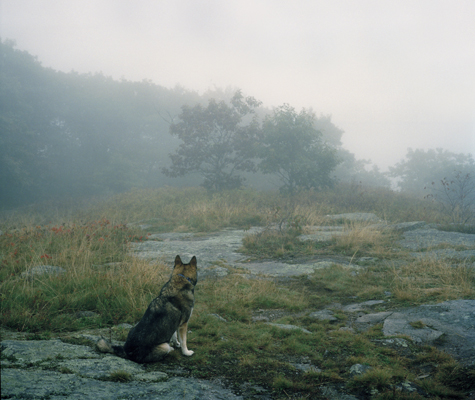
“XXXI” C-print by Mikael Kennedy, 2009. |
Mikael Kennedy’s portraits of his maunderings through the American landscape harness a transcendental concurrence of vastness and intimacy. As drenched in hazy and thick atmosphere as in nostalgia, Kennedy’s photographs stand as rosary beads, marking haloed moments of confrontation between contentment and restlessness. “Saltwater River Guard,” on view at the appropriately rustic-chic 37-A Gallery, is comprised of two series of Kennedy’s work, both documenting travels during the summer of 2009. Seven Polaroid images taken in Bristol, Vermont, and Lincolnville, Maine, hang neatly in a row on the back wall of the gallery, flanked by seven larger scale C-prints from his series “The Odysseus,” all framed in rough wood.| "SALTWATER RIVER GUARD" | Polaroids and C-prints by Mikael Kennedy | through July 30 | at Gallery 37-A, 37A Wharf St, Portland | thirtysevena.com |
Kennedy’s Polaroids read like a narrative-diary film reel, capturing lazy sun-drenched stills of his companions. The larger prints smartly blow out themes planted in the smaller works, shifting the focus from communal to personal. Titled “XXXI” through “XXXVII,” these works are not just larger in scale but in scope, chapters in Kennedy’s Homeric journey.
The 31-year-old Kennedy has been chronicling his transient life with a used Polaroid camera for the last 12 years, using the camera, as he has titled several self published books, as a “Passport to Tresspass.” A recent solo exhibit at the Chelsea Hotel in New York City showed 500 of these images, threading Kennedy to a host of his evident progenitors, Allen Ginsberg, Jack Kerouac, and fellow Polaroid enthusiast Robert Mapplethorpe among them.
The pared-down group of Polaroids here are a ghostly set — the film perhaps expired, with a yellowed and purpled wash placing the images securely in a blissed-out bubble. Figures lounge on rocks and bathe in rivers, often with backs turned to the photographer, a stoic calm heavy among them. These images appear so rooted in nostalgia, both in format and in subject matter, so connected to an idealism already canonized, the question arises: Why now? Is Kennedy asserting a forged severance from contemporary conveniences and reconnection to intuition, impulse and risk? Or simply reminding us it is still possible? Regardless of their conceptual merit, the nature of the contemporary context of Polaroid film runs the risk of subscribing to an overdone aesthetic, the snapshots of nude friends a recycling. Rescuing the work from any belaboring are their exquisite compositions and consistent ethereal white light, enveloping Kennedy’s subjects. Ultimately, the Polaroids feel like sketches to the matured C-prints.
Kennedy’s larger works are painterly, with mist or stark light harshly defining and rubbing out lines, creating a dense and sophisticated compass of texture. Dramatic perspectives feature the weight of the sky and distant horizons as subjects. In “XXXIV” a river-scape is merely suggested through a milky fog that abstracts the view, the darkness of islands and a tree line slowly emerging as formal elements. The weight of the atmosphere is dizzying.
A single male figure stands small, challenging a churning river in “XXXVI,” swallowed by the blackness of overhanging trees, his profile glowing at the heart of the composition. The seascape in “XXXIII” is both meditative and harsh, with rocks covered in gristly seaweed framing turbulent waters turned sky. Works from “The Odysseus” convincingly reflect a transcendental experience of engaging with the American landscape in solitude, are sincere, and are simply beautiful.
Annie Larmon can be reached at aglarmon@gmail.com.